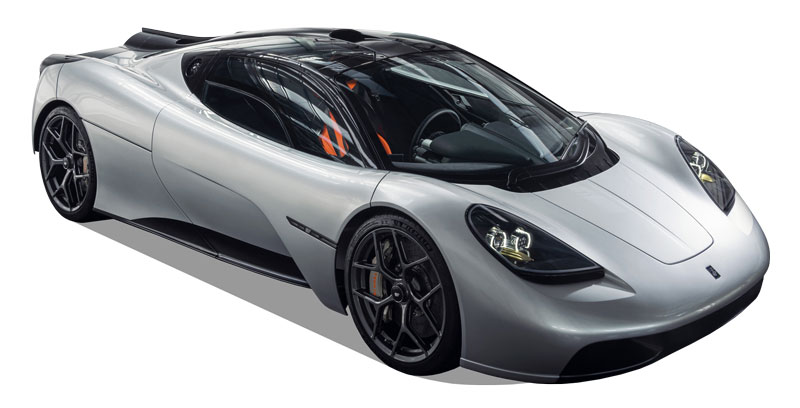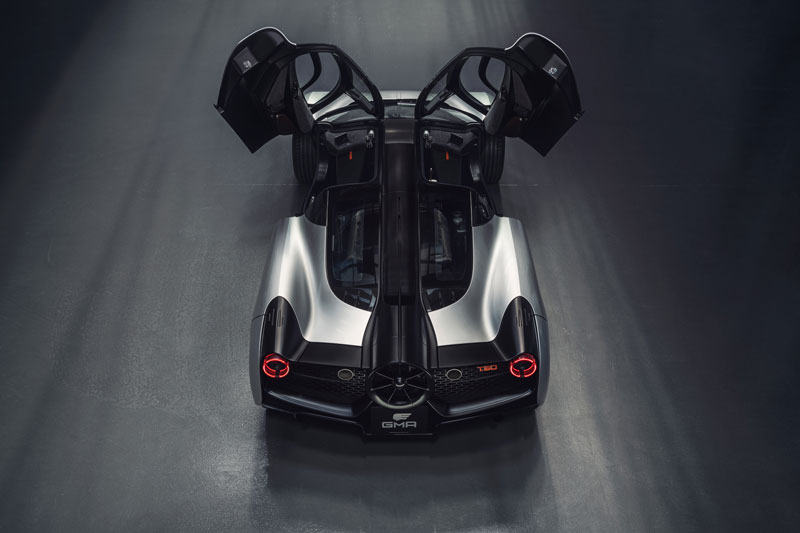The GMA T.50

Something a little different this month, as we take a look at what may be the ultimate naturally aspirated supercar.
Revealed in August, the T.50 has sprung from the keen mind of automotive design guru Gordon Murray, the main brain behind the McLaren F1, the car that in most people’s estimation currently sits atop the mountain of great ‘analogue’ supercars.
38 years after that masterpiece, the T.50 is the culmination of a lifetime’s work in the automotive and motorsport arenas for Murray – he designed cars for both the Brabham and McLaren Formula One teams in the 1970s and 1980s as well as the McLaren F1 – and his new supercar, built by his company Gordon Murray Automotive (GMA), features technology and innovations pulled from across his extraordinary career.
Most obvious of these is the three-seat arrangement of the mid-engine, rear-wheel-drive T.50 cabin. With this set-up, the driver is sat in the centre with two passenger seats flanking and slightly behind the driver’s seat. This layout is one we all recognise from the McLaren F1.
The second obvious feature is the massive fan at the rear of the car.
An innovation that Murray first utilised in the controversial Brabham BT46 B Formula One ‘fan car’ that competed in 1978 (that car raced just once, winning the Swedish Grand Prix), the fan is a radical piece of engineering that draws air from under the car, reducing pressure and creating huge amounts of downforce.
The T.50’s 400mm fan and associated ducting system will, GMA says, manage both underbody and overbody airflow and through the application of two automatic and four driver-selected aero modes – which alter the settings of the fan and other aerodynamic features such as the pair of active spoilers at the rear – increase downforce by 50 per cent, reduce drag by 12.5 per cent, add around 50hp (37kW) of output, and cut braking distance by 10m from 150mph (241km/h). Incredible stuff.
While the rear fan and three-seat layout may catch the eye, it is the bespoke engine, developed by Cosworth, that will give the T.50 its as yet unpublished, but sure to be staggering, performance.
The 3.9-litre V12 redlines at 12,100rpm, making it the highest-revving naturally aspirated road car engine ever, and delivers its maximum power of 654hp (488kW) at 11,500rpm. That means it is punching out an astonishing 122kW per litre. Using V-Max Boost mode raises that output to 690hp (515Kw).
Max torque of 467Nm arrives at 9,000rpm, but GMA claims that 71 per cent of that power is available at just 2,500rpm. Pretty spectacular stuff, and all coming through a six-speed manual transmission. Oh yes, and the whole engine weighs just 178kg.
Weight is important for a supercar, of course, and the T.50’s chassis and body are entirely constructed from high-grade carbon fibre, making it both light and strong. Remarkably, the T.50’s body, including the carbon monocoque and all body panels, tip the scales at less than 150kg. All-up, in fact, the T.50 weighs just 986kg.
“Weighing just 986kg, the T.50 undercuts the average supercar weight by almost a third,” said Murray. “A heavy car can never deliver the dynamic attributes of a lighter car – even if it has the same power to weight ratio. While it is possible to disguise a heavy car’s dynamic capabilities with complex active suspension and sophisticated electronics, the agility, responsiveness and reward of a lightweight vehicle simply cannot be matched.”
On the inside, plenty of effort has been put into making the T.50 as comfortable for the enthusiastic driver as possible.
To the right of the driver, the titanium gearstick sits on an arm that extends alongside the driver’s seat. The arm itself features controls including the drive mode selector, infotainment rotary control, and a centrally positioned engine start / stop button.
There’s a three-spoke carbon-fibre steering wheel behind which are left- and right-hand paddles that enable the driver to sound the horn or flash the headlights without taking their hands off the wheel. There are no touchscreens and no stalk controls – even the indicators are operated by thumb-buttons on the steering wheel’s horizontal spokes.

Sticking to the analogue philosophy for the T.50, GMA says that ‘every control is analogue, every display is designed for functional clarity, every primary and secondary control switch is satisfyingly tactile and ergonomically positioned for ease of use’.
“Everything about the interior starts with the driver – the central driving position is the clearest demonstration of this approach,” said Murray. “Building on this starting point, every control is arranged within easy reach of the driver. Purity of design was our goal, with the utmost quality applied to every element.”
Light, powerful, comfortable, and beautiful, the T.50 could be the supercar every serious enthusiast has been waiting for.
“From the first touch of the titanium throttle pedal to the V12 screaming at 12,100rpm, the driver experience will surpass any supercar ever built,” said Murray. “No other road car can deliver the package of power, instant responsiveness and driver feedback in such a direct and focused way while remaining comfortable, refined and usable every day.”
For anyone thinking they might want a piece of this particular supercar action, deep pockets are a must. Just 100 T.50s are to be made, and the price tag is a whopping £2.36 million ($AU4.31 million) price tag.
It might be worth remembering, however, that the McLaren F1 was priced at £635,000 ($AU1.16 million) when it was released in 1992. Today, you’ll need somewhere around £16 million ($AU29.2 million) to get your hands on one. If the T.50 is anywhere near as good a car – and it certainly sounds like it will be – then it may well be a good investment.
Source: Motor Trader E-magazine (September 2020)
15 September 2020









